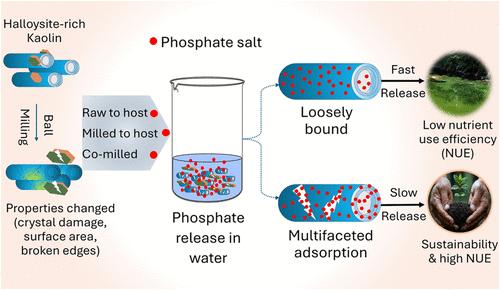Mechanochemically Activated Halloysite Nanotube-Rich Kaolin Clay As a Carrier for Slow-Release Phosphate Fertilizer
IF 7.3
1区 化学
Q1 CHEMISTRY, MULTIDISCIPLINARY
引用次数: 0
Abstract
Formulation of sustainable slow-release phosphate (SRP) fertilizers using low-cost carrier materials is a growing area of research. This fertilizer can prevent its nutrient loss caused by surface runoff or soil leaching. Here, we investigated the mechanochemical activation of halloysite-rich kaolin clay by planetary ball milling and produced an enhanced SRP fertilizing substrate. The milling process was carried out under dry (clay only and KH2PO4 solution added after milling) and wet conditions (slurry of clay and KH2PO4) over varying durations (e.g., 1–8 h). Changes in crystallinity and microstructure of materials induced by milling were characterized by X-ray diffraction and electron microscopy. The retention and release of phosphate from the water-extractable phase of the fertilizer were also analyzed. High-resolution transmission electron microscopy mapped the elemental distribution at the crystal scale. The milling method had a pronounced effect on the phosphate release behavior. Dry-ground materials (3–5 h) showed better retention and controlled release (∼40% phosphate released in the first wash followed by ∼5% in two successive washes). However, wet-ground samples released more phosphate initially (∼50%), leaving less for later release. Compared to wet milling, dry milling caused greater crystal damage, particularly halloysite tube breaks, and increased the amorphousness of the material. These affected the containment of KH2PO4 salt into halloysite lumen and the release of phosphate ions in the water phase. This provides a choice of fertilizer formulations simply by adjusting milling conditions. To move forward, we need to study the scale-up of this potentially sustainable slow-release phosphate fertilizer and test it in soil and crops. This will benefit raw mineral resources and improve the nutrient efficiency.

机械化学活化富纳米管高岭土作为缓释磷肥载体的研究
使用低成本载体材料配制可持续缓释磷酸盐肥料是一个日益增长的研究领域。这种肥料可以防止因地表径流或土壤淋滤造成的养分损失。在此,我们通过行星球磨研究了富含高岭土的高岭土的机械化学活化,并生产了一种增强的SRP施肥基质。碾磨过程在干燥(仅粘土和碾磨后加入KH2PO4溶液)和潮湿条件(粘土和KH2PO4浆液)下进行,持续时间不同(例如1-8小时)。利用x射线衍射和电子显微镜对铣削引起的材料结晶度和微观结构的变化进行了表征。还分析了磷在肥料水提相中的滞留和释放情况。高分辨率透射电子显微镜在晶体尺度上绘制了元素分布图。铣削方法对磷酸盐的释放行为有显著影响。干磨材料(3-5小时)表现出更好的保留和控释(第一次洗涤释放约40%的磷酸盐,随后两次连续洗涤释放约5%)。然而,湿地样品最初释放出更多的磷酸盐(约50%),留下较少的磷酸盐供以后释放。与湿法铣削相比,干法铣削造成了更大的晶体损伤,特别是高岭土管断裂,并增加了材料的非晶性。这些影响了KH2PO4盐在高岭土管腔中的遏制作用和磷酸盐离子在水相中的释放。这提供了一个选择的肥料配方,只需调整碾磨条件。为了向前迈进,我们需要研究这种潜在的可持续缓释磷肥的规模,并在土壤和作物中进行测试。这将有利于原矿产资源的利用,提高养分利用率。
本文章由计算机程序翻译,如有差异,请以英文原文为准。
求助全文
约1分钟内获得全文
求助全文
来源期刊

ACS Sustainable Chemistry & Engineering
CHEMISTRY, MULTIDISCIPLINARY-ENGINEERING, CHEMICAL
CiteScore
13.80
自引率
4.80%
发文量
1470
审稿时长
1.7 months
期刊介绍:
ACS Sustainable Chemistry & Engineering is a prestigious weekly peer-reviewed scientific journal published by the American Chemical Society. Dedicated to advancing the principles of green chemistry and green engineering, it covers a wide array of research topics including green chemistry, green engineering, biomass, alternative energy, and life cycle assessment.
The journal welcomes submissions in various formats, including Letters, Articles, Features, and Perspectives (Reviews), that address the challenges of sustainability in the chemical enterprise and contribute to the advancement of sustainable practices. Join us in shaping the future of sustainable chemistry and engineering.
 求助内容:
求助内容: 应助结果提醒方式:
应助结果提醒方式:


